I started making no-knead bread in 2010 and it has continued to be my favorite way to make homemade bread because it’s incredibly simple, it doesn’t require a lot of effort, and it makes the most deliciously crusty bakery-style bread ever. To make this no-knead bread recipe you only need four ingredients (including water) and a little bit of time. No fancy equipment or techniques needed!
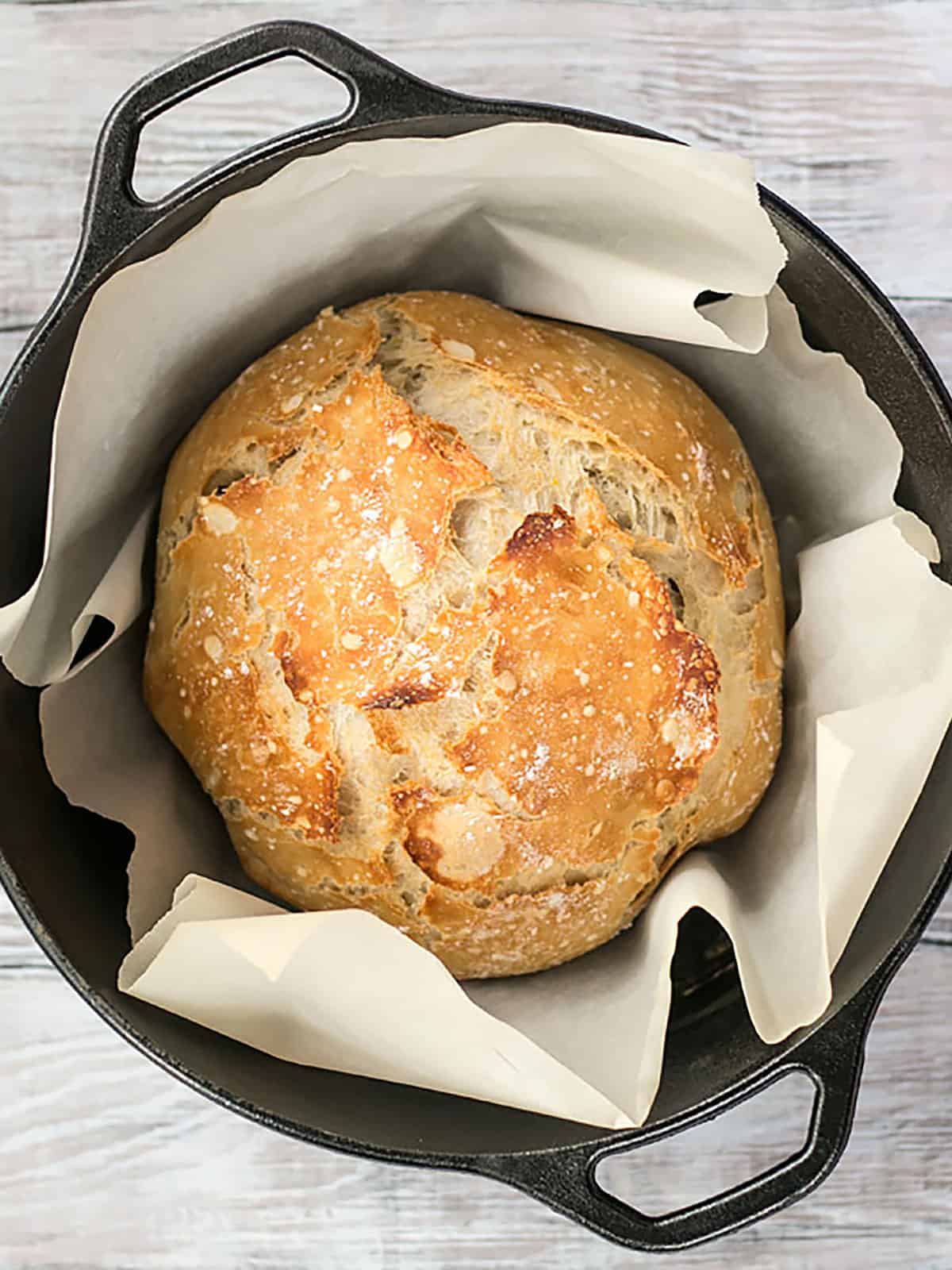
This post contains some affiliate links, which means that we make a small commission off items you purchase at no additional cost to you.
“I’ve made this twice and it was amazing! Hard to believe something so simple can come together to be something so amazing!”
-Melissa
What Is No Knead Bread?
No-knead bread is an ancient technique for making delicious loaves of bread by utilizing a long fermentation time to develop the gluten the flour instead of hand kneading. Gluten is the protein that gives bread its strength, allowing it to rise into a fluffy loaf, and have that deliciously chewy texture. Kneading bread dough develops gluten quickly, but is quite labor-intensive. If given enough time, yeast can develop the gluten in the dough without the need for manual needing.
Ingredients for No Knead Bread
The best part about this no-knead bread recipe is that it only requires four ingredients, including water, and you still get an incredibly flavorful bread. Here’s all you’ll need to make your own homemade no-knead bread:
- Flour: Our version of no-knead bread was developed using all-purpose flour because that is what we most commonly have on hand. That being said, using bread flour will create even better results. Just keep in mind that bread flour tends to absorb more water than all-purpose flour, so you may need to adjust the ratios slightly.
- Yeast: For this type of bread, we use instant yeast or bread machine yeast, both of which do not need to be activated first by proofing in warm water. You can simply add them to your dry ingredients and go!
- Salt: Without the proper amount of salt, homemade bread will have no flavor, so it’s imperative that you do not skip the salt.
- Water: Water hydrates the flour to create the dough. Because this technique uses a longer ferment time, you can use room-temperature water and you do not have to “wake up” the yeast with warm water. The yeast will have plenty of time to activate as it rests.
What Kind of Yeast to Use
It’s very important to use the correct type of yeast for this recipe. Instant yeast and bread machine yeast are special because they do not require mixing with warm water to “wake up” before adding to a recipe. You can simply stir them into the dry ingredients and they will activate instantly upon hydration, so that is what we use for this super simple no-knead bread technique. Active Dry yeast, on the other hand, needs to be specifically activated in warm water first. If you use active dry yeast in this recipe using the technique below, the bread will likely not rise.
Do I Need to Use a Dutch Oven?
Using a preheated Dutch oven does create the best results because it gives the bread an extra intense boost of heat while retaining all of the moisture and steam. That being said, I have made no-knead bread on a sheet pan with great results! I suggest adding a pan with an inch or so of water on the bottom rack of your oven to create steam if you’re baking your bread on a sheet pan.
If possible, I would suggest investing in a Dutch Oven because they are easily one of the most flexible and useful pieces of cookware. We love our Amazon Basics 6-Quart Enameled Dutch Oven as a very affordable alternative to Le Creuset. Lodge also makes very affordable Enameled Dutch Ovens and plain Cast Iron Dutch Ovens (like the one used in the photos here).
Short Fermentation vs. Long Fermentation
You can make no-knead bread using either a long fermentation (12-18 hours) or a short fermentation (about 2 hours). The difference is that you’ll need more yeast to do the short fermentation and the flavor does not develop quite as deeply. That being said, short fermentation no-knead bread is a great option when you haven’t planned ahead!
Long Fermenation: Follow the instructions below, using ¼ tsp yeast and fermenting the dough for 12-18 hours.
Short Fermentation: Use 2 tsp yeast (or one ¼ oz. packet) and ferment the dough for about 2 hours at room temperature.
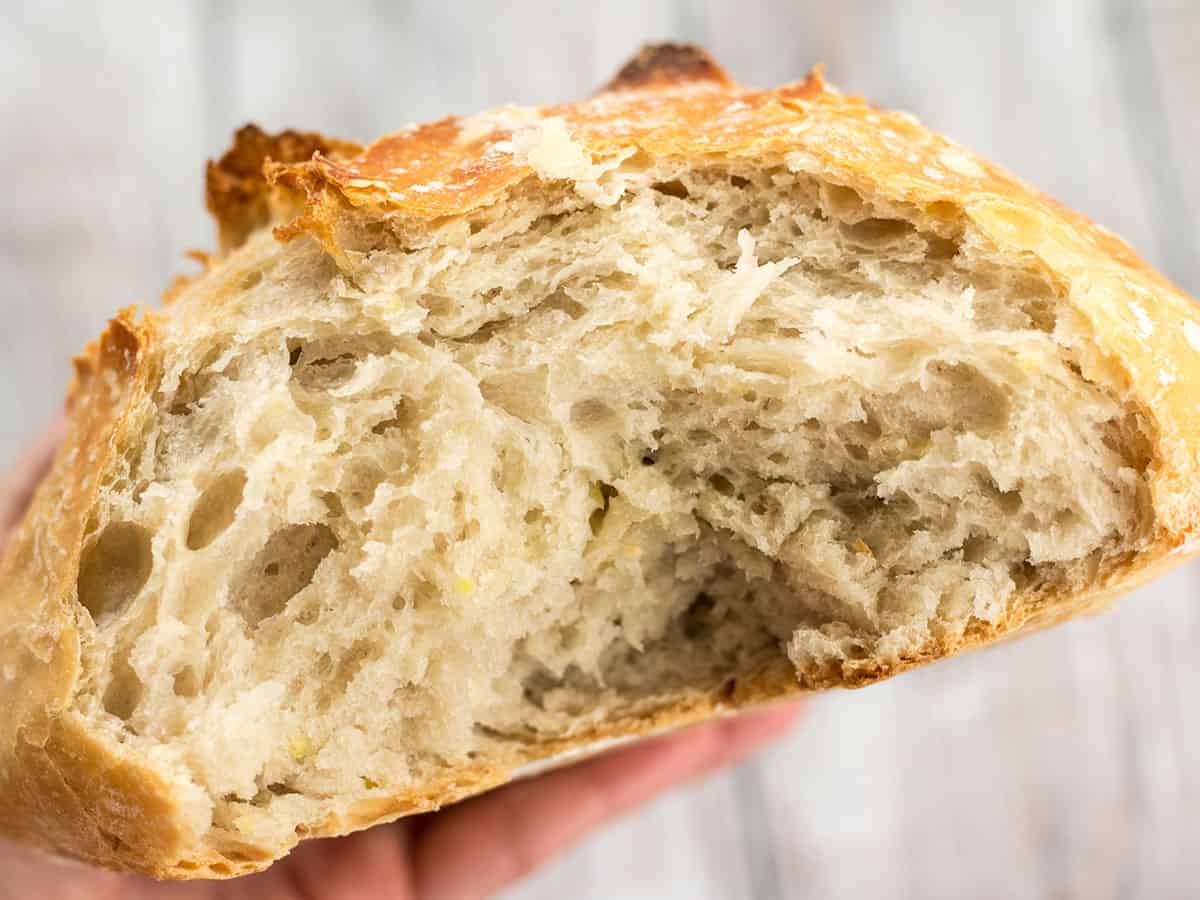
No-Knead Bread
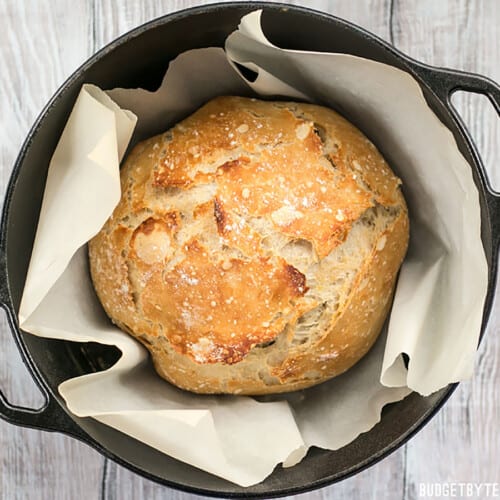
Ingredients
- 3 cups all-purpose flour ($0.29)
- 1/4 tsp instant yeast or bread machine yeast* ($0.02)
- 1.5 tsp salt ($0.02)
- 1.5 to 1.75 cup water** ($0.00)
Instructions
- The day before baking, combine the flour, yeast, and salt in a large bowl and stir until they're well combined. Stir in about 1.5 to 1.75 cups room temperature water until a shaggy, sticky ball of dough forms and there is no dry flour left on the bottom of the bowl. The dough should be wet and sticky, but not so wet that it appears glossy. Cover the bowl loosely with plastic and let it sit at room temperature for 12-18 hours.
- The next day, the dough should be fluffy and very bubbly. When you're ready to bake, sprinkle a little flour on top of the fermented dough and scrape it out of the bowl. With well-floured hands, shape the dough into a ball and place it on a piece of parchment paper. Let the dough rise for 30-60 minutes.
- While the dough is rising, preheat the oven to 425ºF, or the highest recommended temperature listed on the packaging for your parchment paper. Place the Dutch oven inside the oven as it preheats, and make sure it sits in the fully heated oven for at least 15 minutes before baking the bread.
- Once the bread has risen and the Dutch oven is fully heated, carefully remove the Dutch oven from the oven (it will be EXTREMELY hot). Lift the parchment with the dough straight into the dutch oven and cover it with the lid.
- Return the Dutch oven to the oven and bake for 30 minutes. Carefully remove the lid and bake for another 15-20 minutes, or until the crust is a deep golden brown. Remove the Dutch oven from the oven, lift the bread out by by using the parchment paper, and allow it to cool before cutting open and serving.
Sheet Pan Instructions
- Ferment and shape the dough as described above, then place it on a parchment-lined sheet pan to rise for an additional 30 minutes.
- Place a baking pan with about an inch of water on the bottom rack of the oven, then preheat to 425ºF while the dough rises.
- Once the loaf has risen for 30 minutes and the oven is fully preheated, carefully score the top of the dough with a sharp knife (use horizontal motions with no downward pressure). Transfer the sheet pan to the oven and bake for 40 minutes, or until the crust is deeply golden brown and the loaf sounds hollow when tapped.
See how we calculate recipe costs here.
Equipment
- Cast Iron Dutch Oven
- Mixing Bowls
- Parchment Paper
- Liquid Measuring Cup
Notes
Nutrition
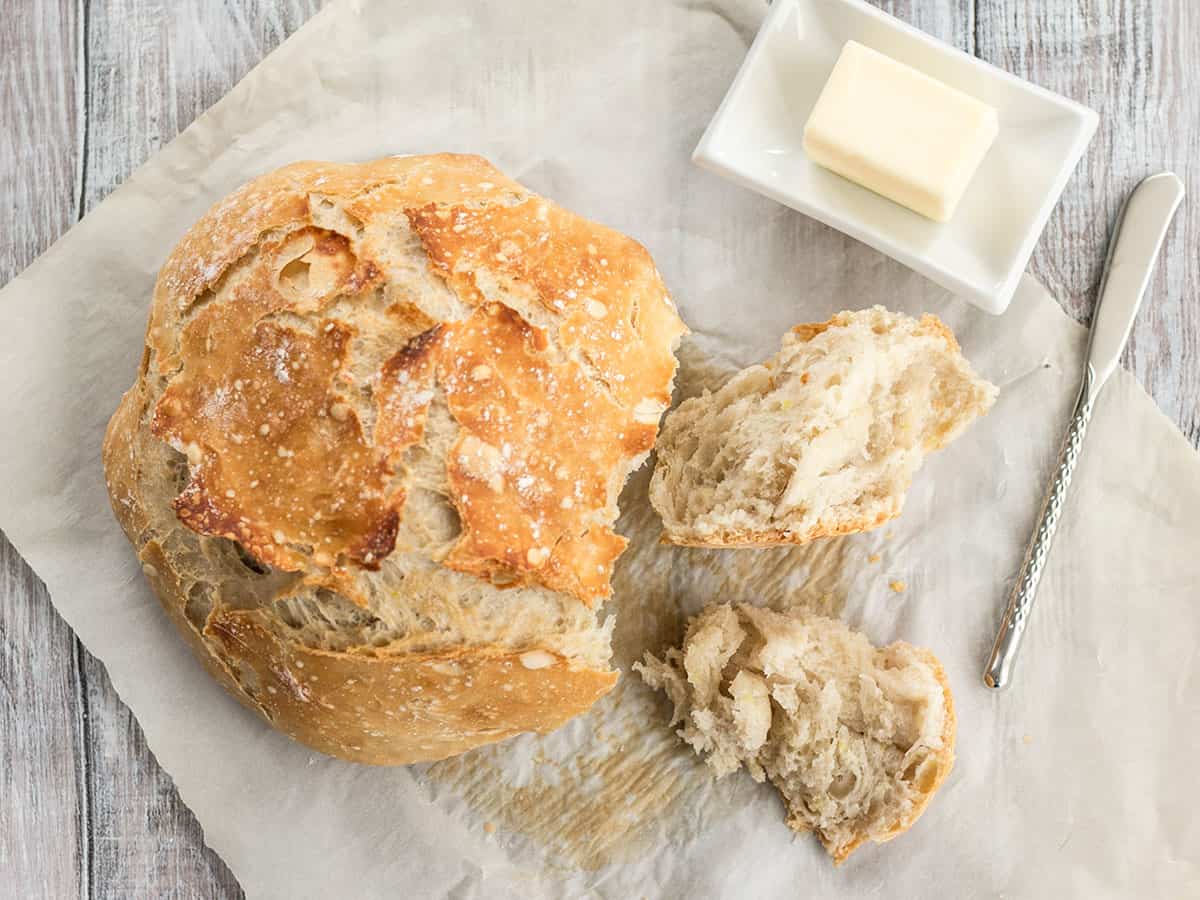
How to Make No-Knead Bread – Step by Step Photos
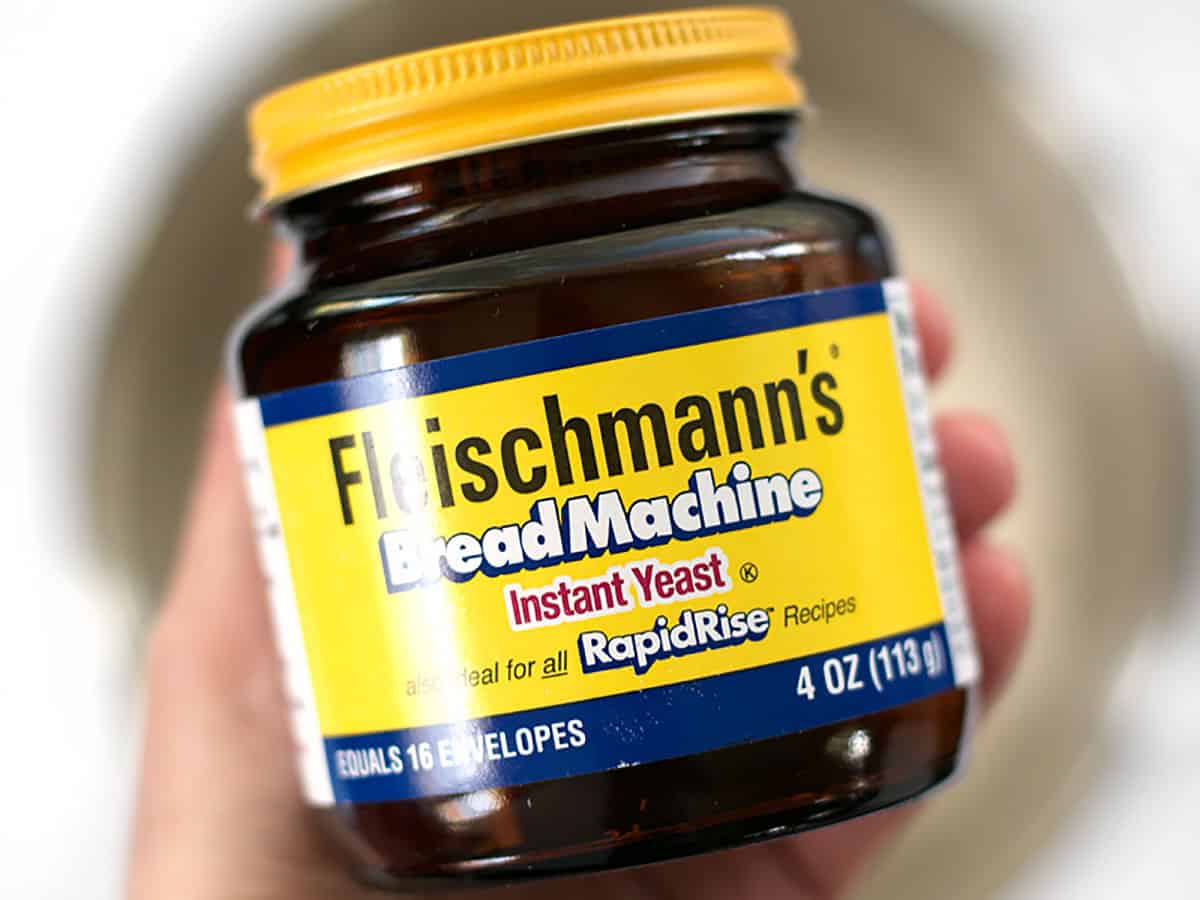
Before you begin, make sure you have “instant yeast” or “bread machine yeast” rather than “active dry”. The reason you need this type of yeast specifically is because it does not need to be kick-started by mixing with warm water first. You can add it to a recipe dry and it will still activate. I buy these little jars, which I keep in my fridge, and they last for-ev-er (especially when you’re only using 1/4 tsp at a time)!
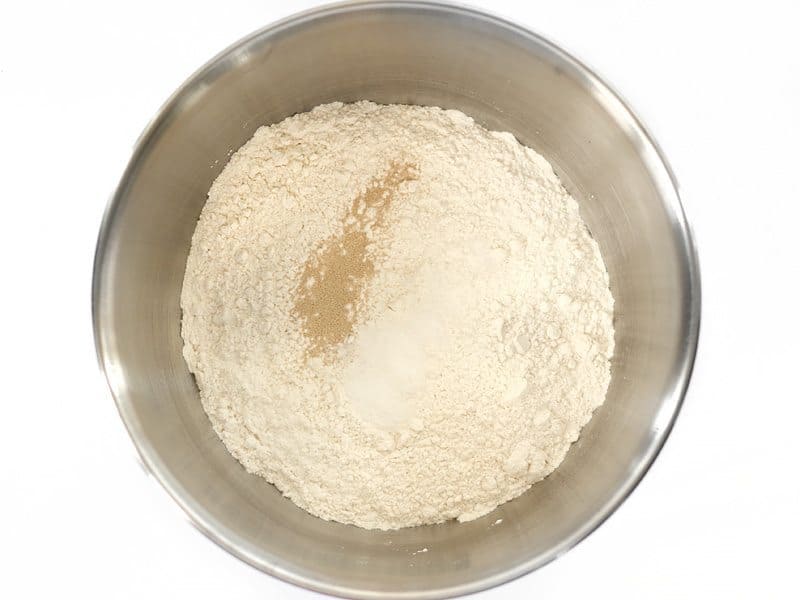
The day before you want to actually bake the bread, combine 3 cups all-purpose flour, 1/4 tsp instant or bread machine yeast, and 1/2 Tbsp salt in a large bowl. Stir them together really well.
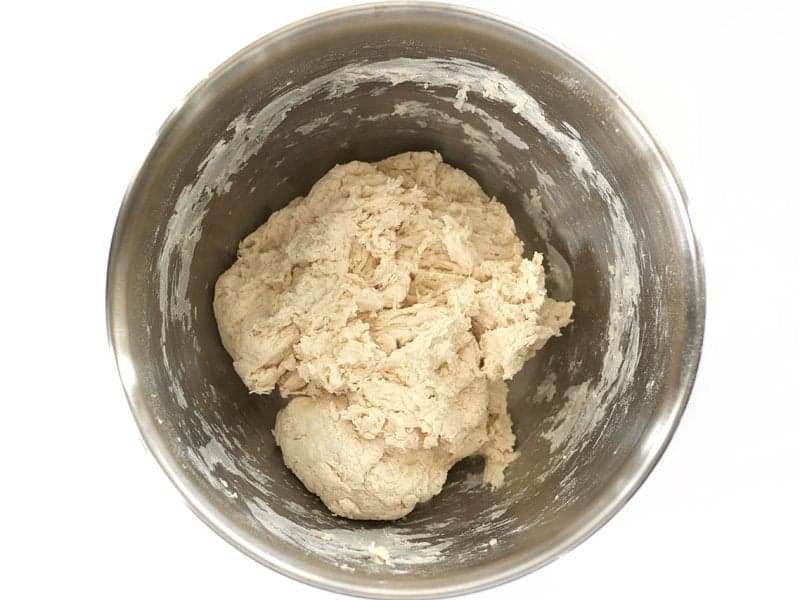
Stir in about 1.5 to 1.75 cups of room temperature water, or just enough to form a shaggy ball of slightly sticky dough, and no dry flour is left on the bottom of the bowl. The total amount of water needed may vary from time to time depending on the ambient humidity and moisture content of the flour, so go on visuals here. Make sure it comes together in one ball and no dry flour is left on the bottom of the bowl. It’s okay for it to be a bit sticky.
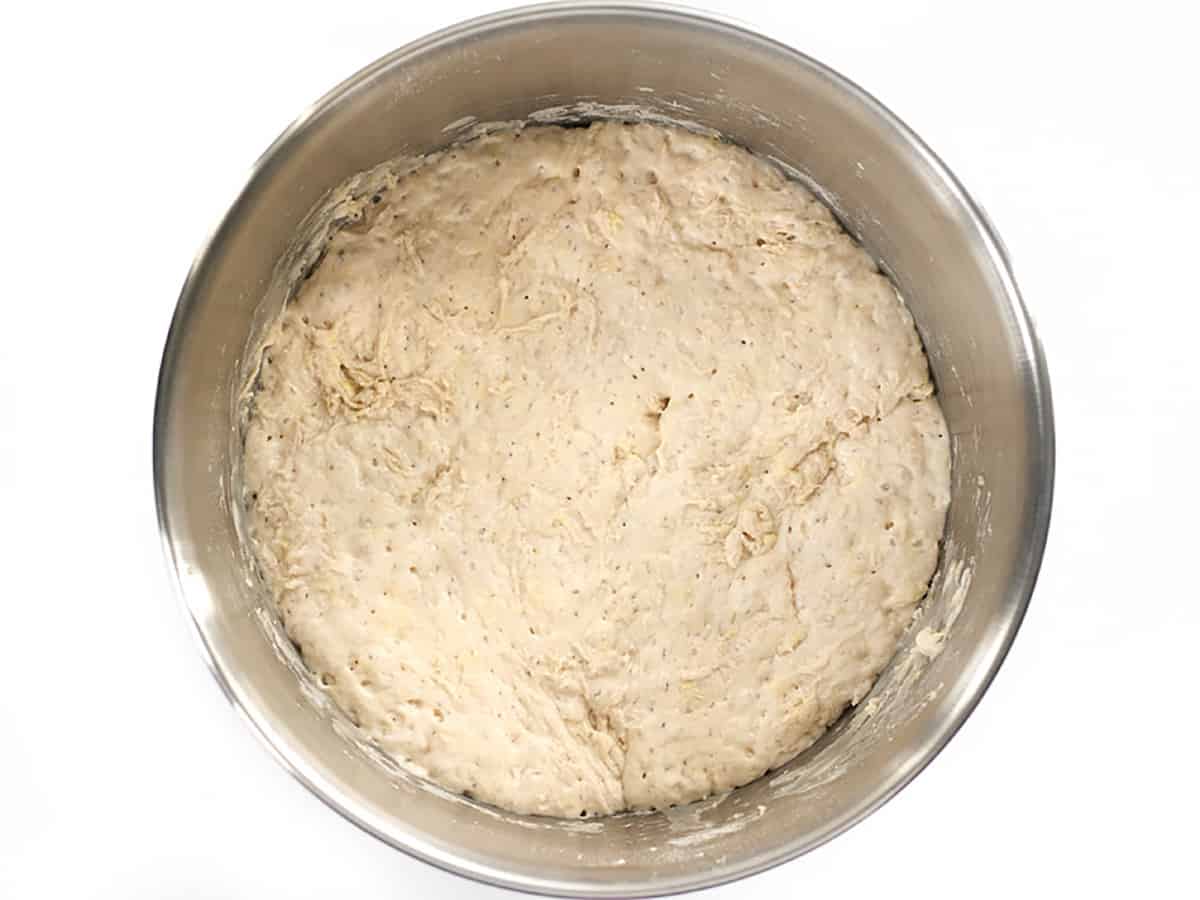
Loosely cover the bowl with plastic and let the dough ferment at room temperature for 12-18 hours. If you need to let it sit longer than that to fit your schedule, just transfer it to the refrigerator. As the dough ferments, it becomes very big, light, fluffy, and bubbly.
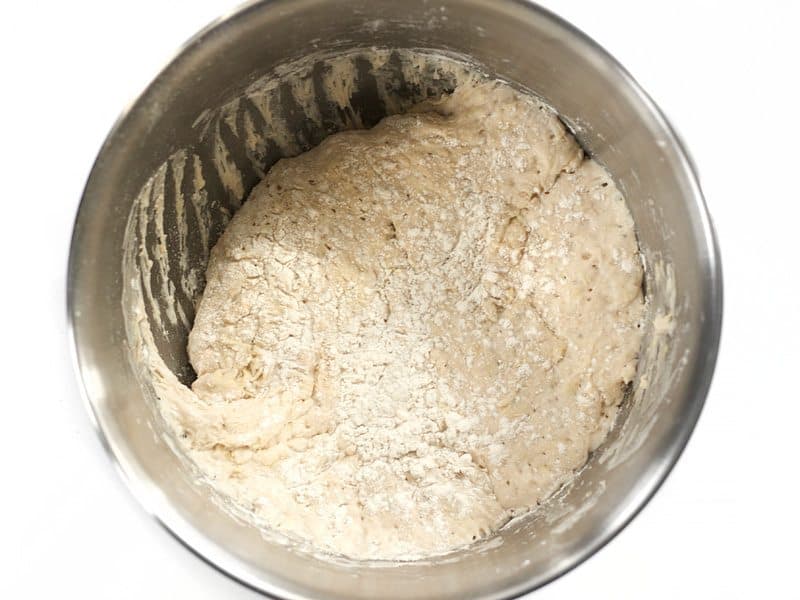
Sprinkle a little flour onto the dough (because it will be sticky) and scrape it out of the bowl. It will begin to deflate as you scrape it out.
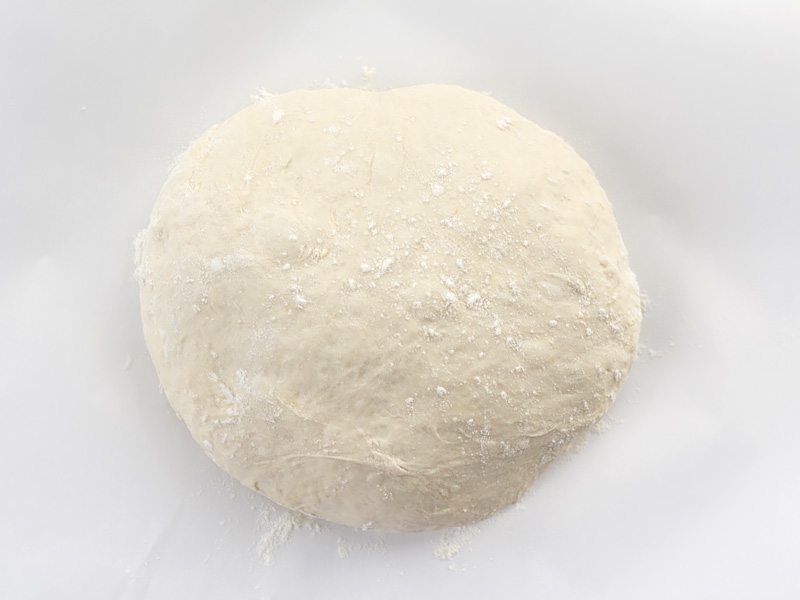
Using floured hands, shape the dough into a ball, then place it on a large piece of parchment. Let the dough rise for 30-60 minutes. The shorter rise time will produce a slightly more dense bread and the longer rise time will have larger bubbles.
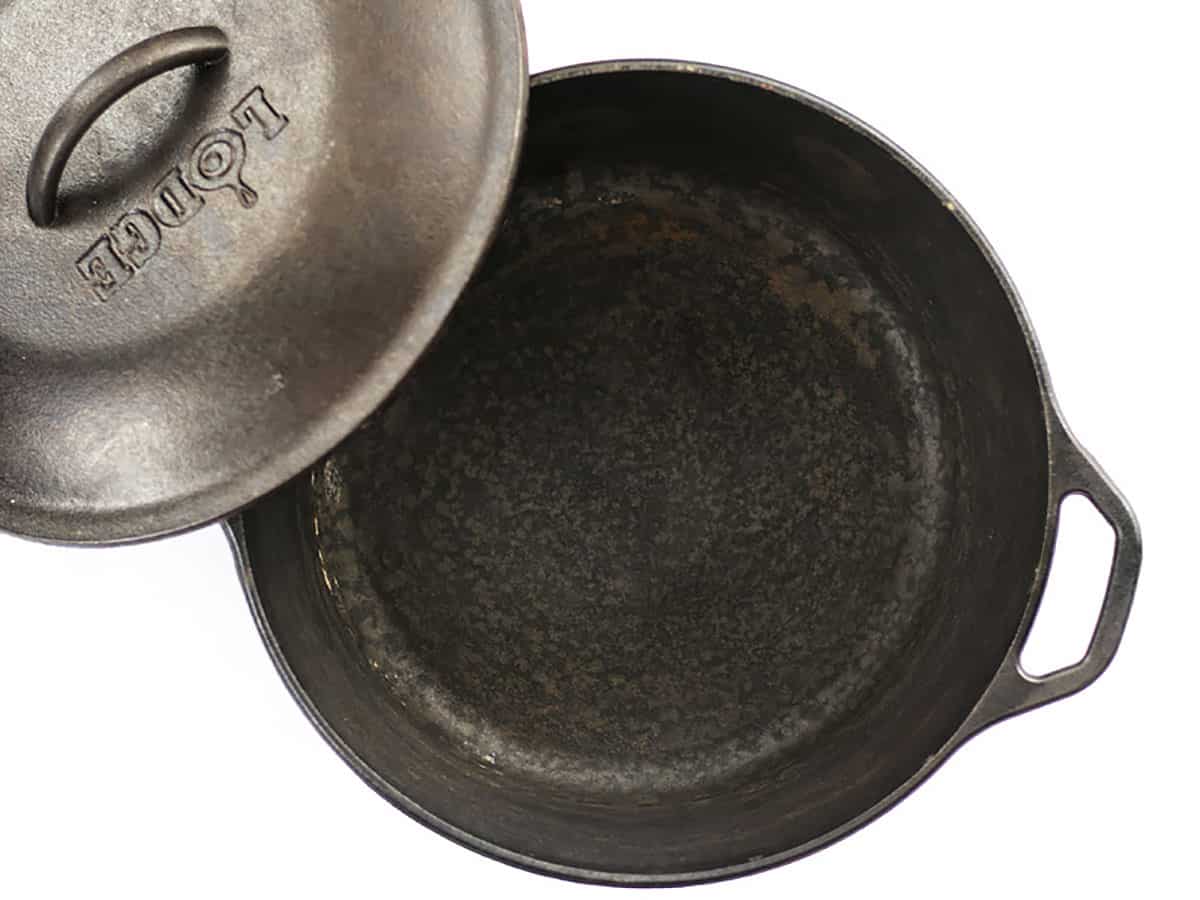
While the dough is rising, begin to preheat the oven and the Dutch oven. Set the oven to 425ºF, or whatever the highest safest temperature is for your brand of parchment (it will usually be listed on the box somewhere). Make sure your Dutch oven is inside the oven as it preheats, and then let it heat for an additional 15 minutes or so once the oven is up to temperature. This makes sure that the Dutch oven is nice and hot.
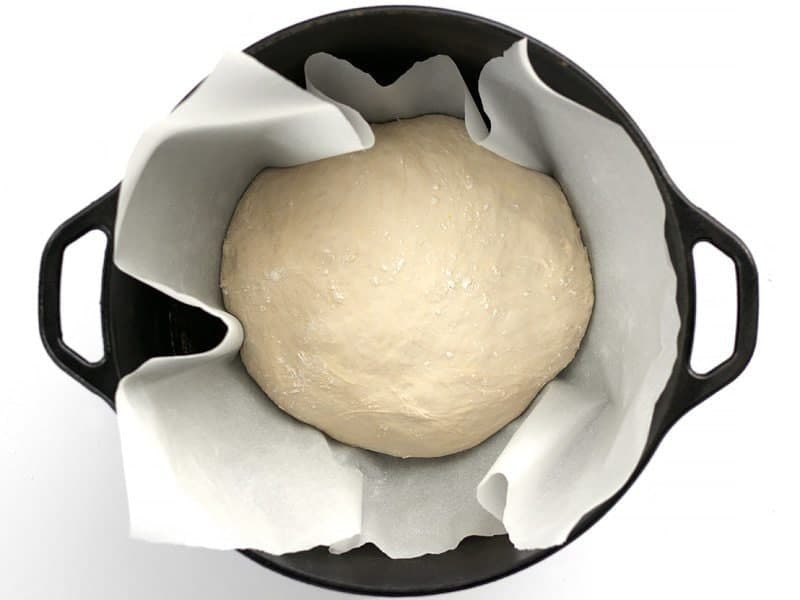
When the dough is risen and the Dutch oven is fully preheated, carefully remove the Dutch oven from the oven (it will be extremely hot!). Lift the risen dough by the parchment and place it inside the Dutch oven, parchment and all. Place the lid on the Dutch oven and return it to the hot oven.
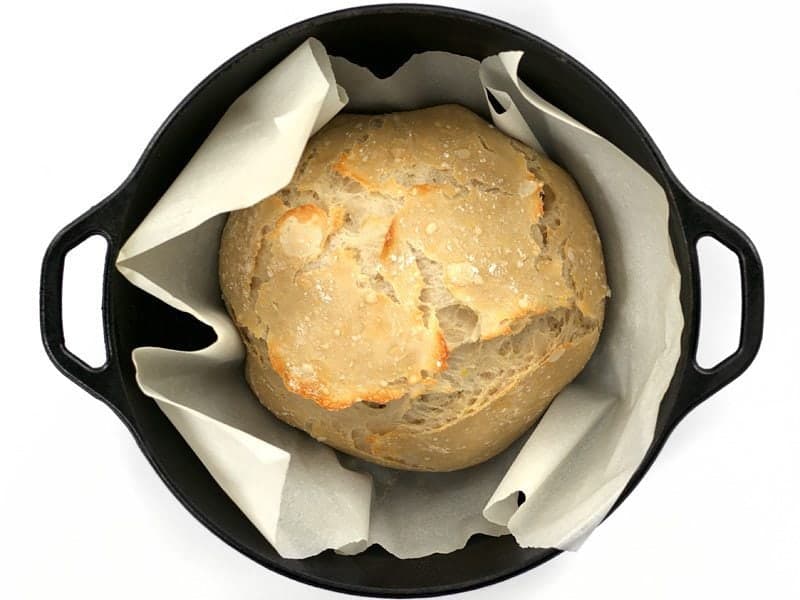
Let it bake for 30 minutes with the lid on the Dutch Oven, then carefully remove the lid…
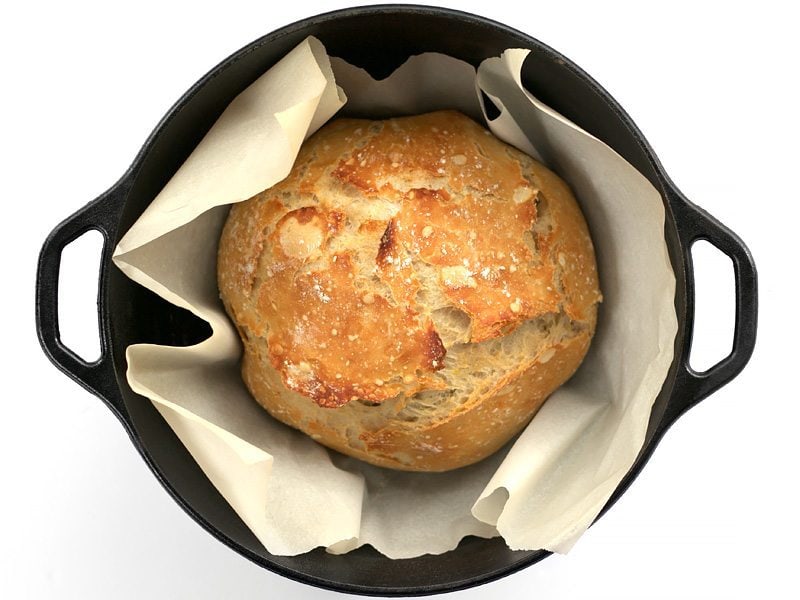
Then bake it for an additional 15 minutes or so WITHOUT the lid to allow the crust to brown.
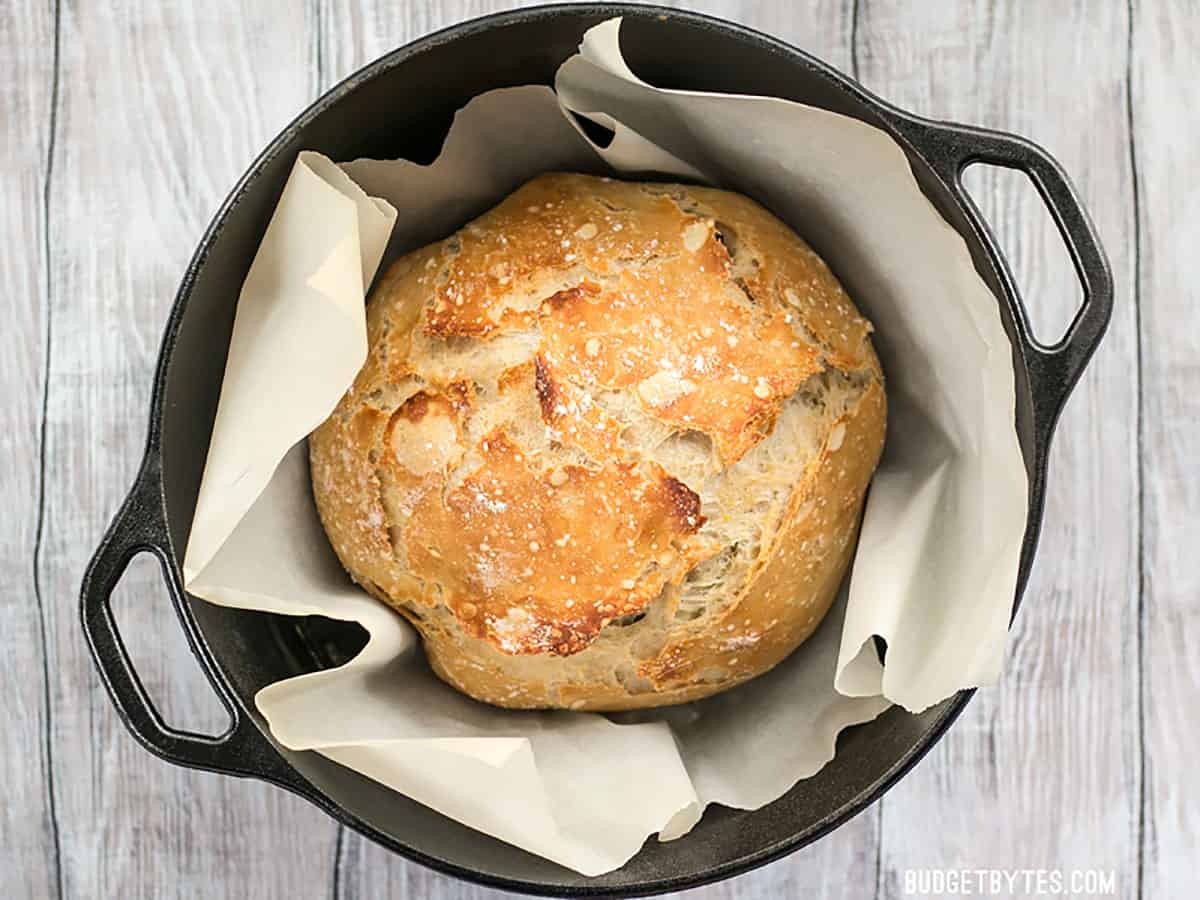
Once the crust achieves a nice deep golden brown color, carefully remove the Dutch Oven from the oven. Lift the no-knead bread out of the Dutch oven by the parchment, and allow it to cool before serving.
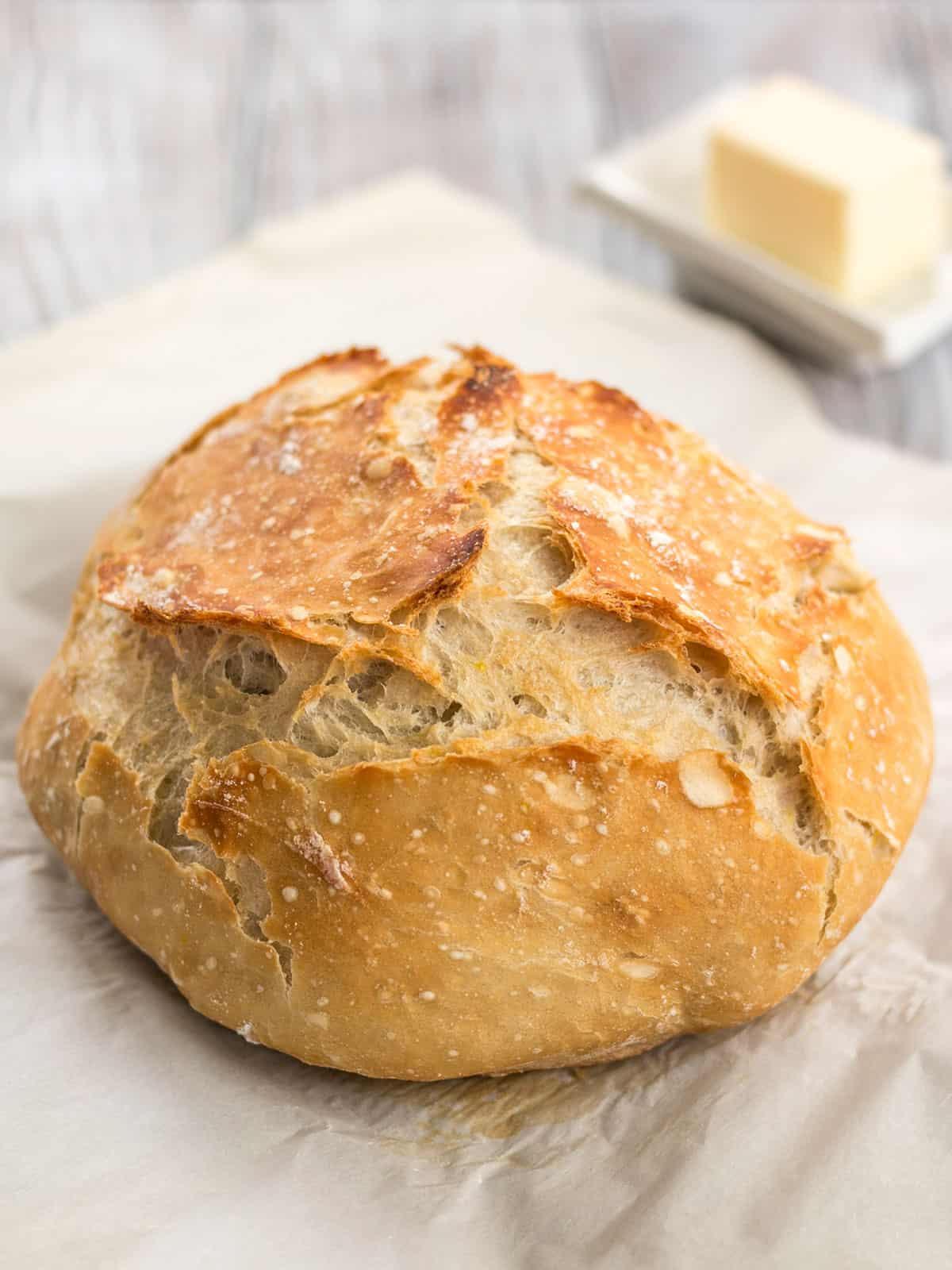
And just be prepared for the BEST bread you’ve ever made yourself. ;) The crust on this no-knead bread is seriously amazing.
No Dutch Oven and Short Fermentation Instructions
So, as I mentioned before, you can still bake this bread without a Dutch oven and with a short, 2-hour fermentation time. Here is a photo of my no-knead bread using just 2 hours of fermentation (plus another 1 hr rise time) and baked on a baking sheet.
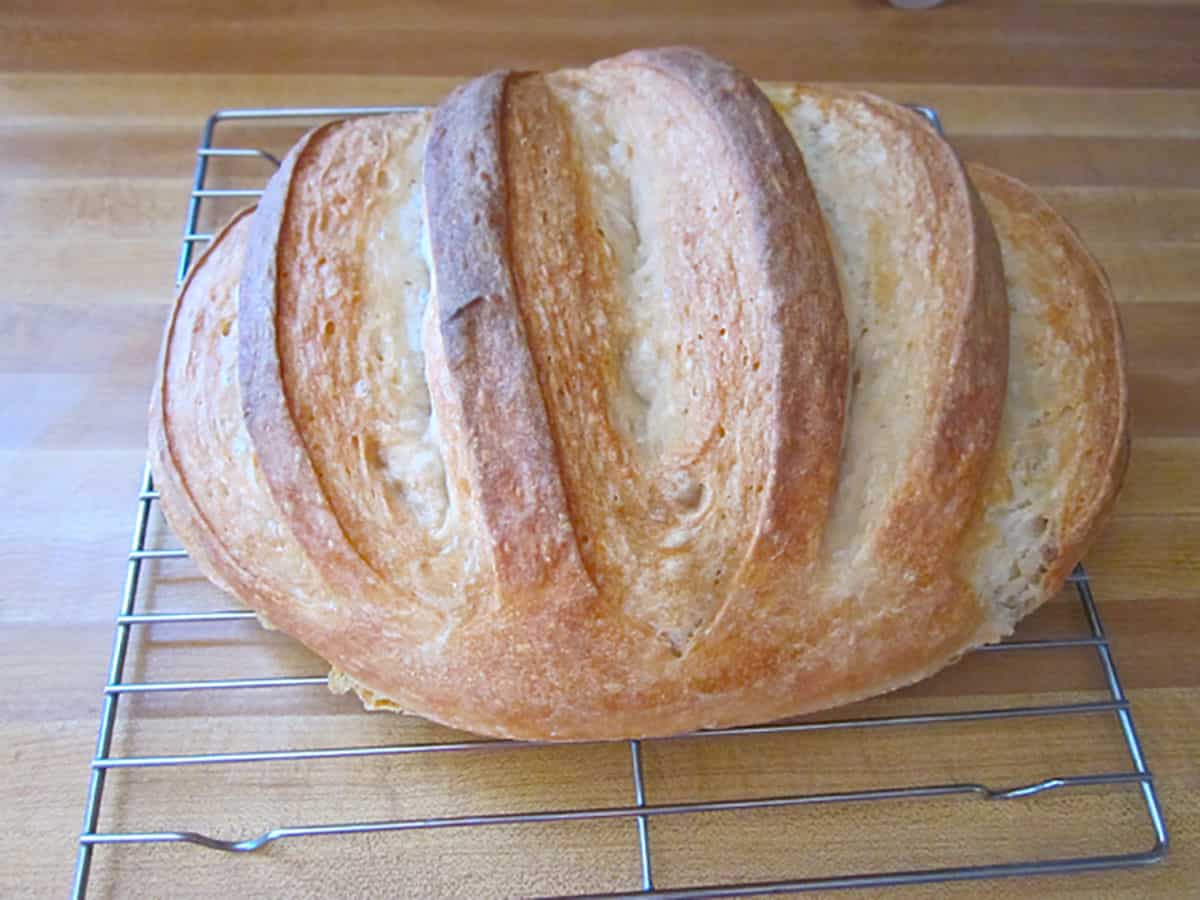
If you only have about 2-3 hours to ferment the dough, you’ll need to increase the amount of yeast used to 2 tsp (instead of 1/4 tsp).
Let the dough ferment in the bowl for 2 hours, then shape it into a loaf, transfer it to a baking sheet covered with parchment (and sprinkled with cornmeal, if desired) and let rise for about another hour. I like to make slits in the top with a sharp knife after the loaf has risen. Be careful though, if the knife is not sharp enough or you use too much downward pressure, it can deflate the dough.
Brush the surface of the dough with water, then bake it in a preheated oven (again, as hot as the parchment will allow, usually around 425ºF) for 30-40 minutes, or until the crust is nicely browned.


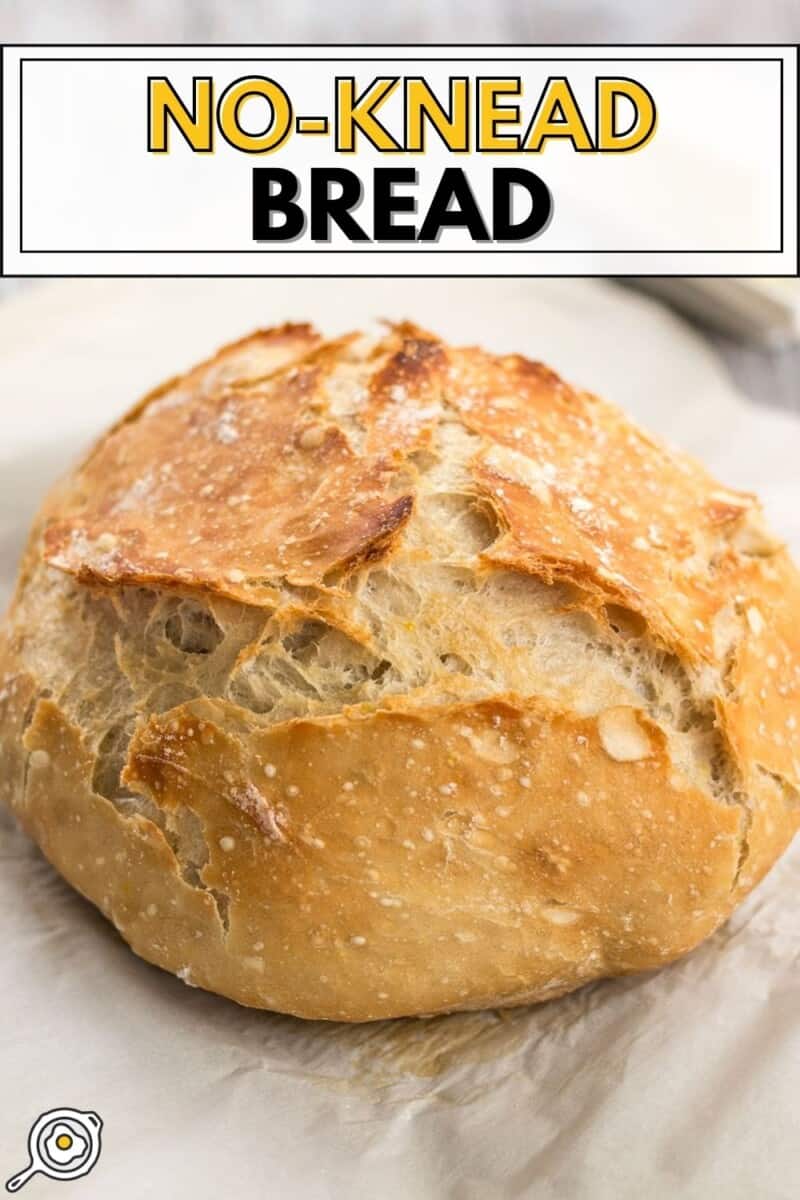
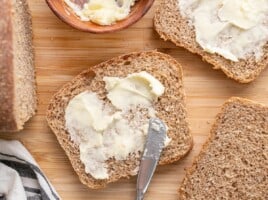
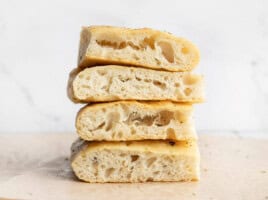
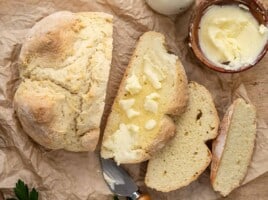
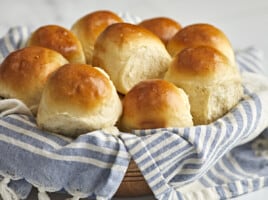
Beth, yes, no-knead bread is a wonderful way to make bread easily with an artisan look and taste. Someone asked about using beer as part of the liquid. Beer is indeed used in the America’s Test Kitchen “Almost No-Knead Whole Wheat Bread” recipe. They call for 3 oz of “mild-flavored” lager, along with 7 oz of water. Interestingly, they also mix in 2 tablespoons honey and 1 tablespoon white vinegar. Also, they suggest laying the parchment paper in a skillet for the first rise is better than placing the paper in a typical deep mixing bowl.
An earlier recipe I found in Mark Bittman’s “How To Cook Everything” cookbook. He gives credit to Jim Lahey, owner of the Sullivan Street Bakery, a Manhattan bread baker, who came up with the “No-Knead” idea which has spread across the US.
Thanks for sharing Dee!
does this work with whole wheat or partially whole wheat flour?
I’ve substituted up to 50% of the flour with WW and had good success. :)
Hi, I have a cast iron pan but no lid, would this work?
I made this bread the first time. It is very easy to prepare and we all loved the taste. Never had homemade bread out of the oven for breakfast. I will make this bread next weekend again. :-)
Hooray! Congrats Ela!
Is there any way I could make it in a bread pan? I wanted to achieve the more square shape so it fits into containers and bags better than round bread.
Unfortunately I haven’t tested this in a bread pan, so I’m not sure how it will affect the outcome.
yes, i’ve done it in a bread pan. takes a bit longer to brown, but it works great for sandwiches. comes out more like a hearty texas toast (heavy, thick, good for soups!)
What size Dutch oven do you recommend? Thank you!
The one I’m using is a 5-quart and you can find more info about it in the paragraph titled “What Dutch Oven Do You Use?” above the recipe.
I’M GIVING THIS FIVE STARS FOR THE TIMES IT TURNS OUT OKAY. MOST TIMES IT IS TOO WET AND DOES NOT RISE. I’VE BACKED OFF THE WATER TO 1 1/4 CUPS. WOULD IT WORK WITH JUST ONE CUP OF WATER? IT’S SO EASY TO MAKE AND MY HUSBAND LOVES IT, BUT I JUST WISH IT WOULD RISE MORE FOR ME.
The dough should be a lot more wet than a traditionally kneaded bread dough. Make sure your oven and the Dutch oven are very hot and have fully pre-heated to get the most “spring” or expansion in the dough when you cook it.
If I want to add black olives to make black olive bread or rosemary olive oil bread, when would you add these ingredients to the dough?
I made a Kalamata version once and added the chopped olives when mixing the dough in the beginning.
I tried your recipe twice with 2tsp of yeast. It does rise as big as your did, maybe like 70%. For some reason it is dense. I gave 2 hours for fermentation and 1 hour for rise time. It did not rise much. Don’t know what i am doing wrong.
How long should I let it sit in the refrigerator instead of just in a bowl on the countertop? I have long hair pets so ew lol
I haven’t tested a refrigerator only version, so I’m not completely sure. You may have to experiment with it the first time. Take a look at the photos in the step by step section and try to wait until it looks like the photo where it has fermented. It should have expanded quite a bit and it will look very fluffy with a lot of bubbles.
I remember my mom would always cover the bowl with a clean dry kitchen towel when she would let dough rest or rise on the countertop. This way, the dough should still be able to breathe, but the towel will keep out anything that might be floating through your kitchen.
Tried this last weekend. Have made it four times since then, my husband and coworkers are obsessed. Perfect recipe, thank you so much!
I lost a no knead beer bread recipe which my husband really liked.
Can I use beer instead of water?
Thank you.
Hmm, I’ve never tried that so I’m not sure how it will work out.
On the water amount, tried with 1.5 cups and it was very runny so backed off to 1.25 cups and still too sticky when trying to make a ball so looks like I’ll have to go with 1 cup only. Any idea where all the moisture is coming from.?.
The dough should be very soft and sticky. If you sprinkle it with a lot of flour when you go to shape it, that will help prevent it from sticking to your hands. But if you don’t add enough water the dough will be too stiff and it will make a very dense loaf.
What if you only have active dry yeast?
Active dry yeast does not activate unless it’s proofed in warm water first, so it won’t work with this particular method. You would need to adjust the method of the recipe and unfortunately I haven’t tested that variation.
I absentmindedly made this exactly per recipe except with active dry yeast, and it came out beautifully, no added steps or ingredients. It was so good that I’m making my fourth loaf in as many days, and only just now noticed the no-active-dry recommendation! (I only swung thru the comments to see if anyone had asked about heating the dutch oven with vs without the lid)
That’s good to know! It may differ depending on the brand, too.
Just add the yeast to lukewarm water and a pinch of sugar first and let it proof. Mix everything else (dry ingredients) per recipe. Once yeast has proofed, add it to the dough when the recipe calls for the water. Voila!
made this with active yeast yesterday-i changed the flour:yeast ratio to 90:1, proofed the yeast in 1 cup of warm water + pinch of sugar first, and followed the rest of the instructions. came out great!
Do you have a gluten free bread recipe? Thanks.
Unfortunately I don’t.